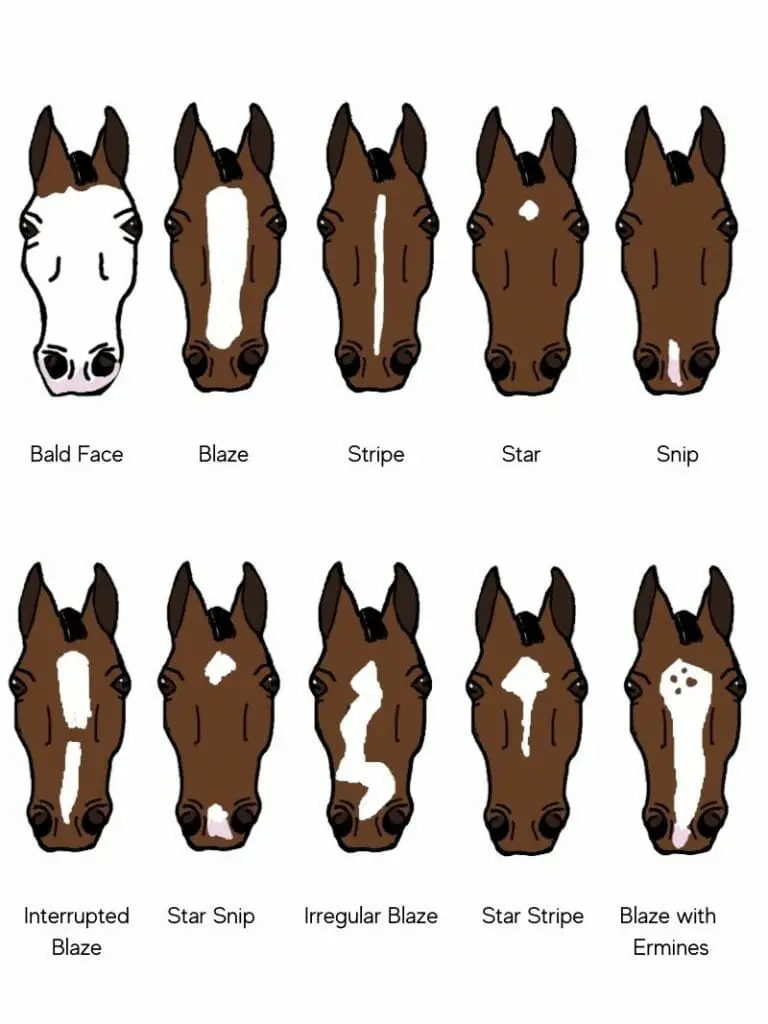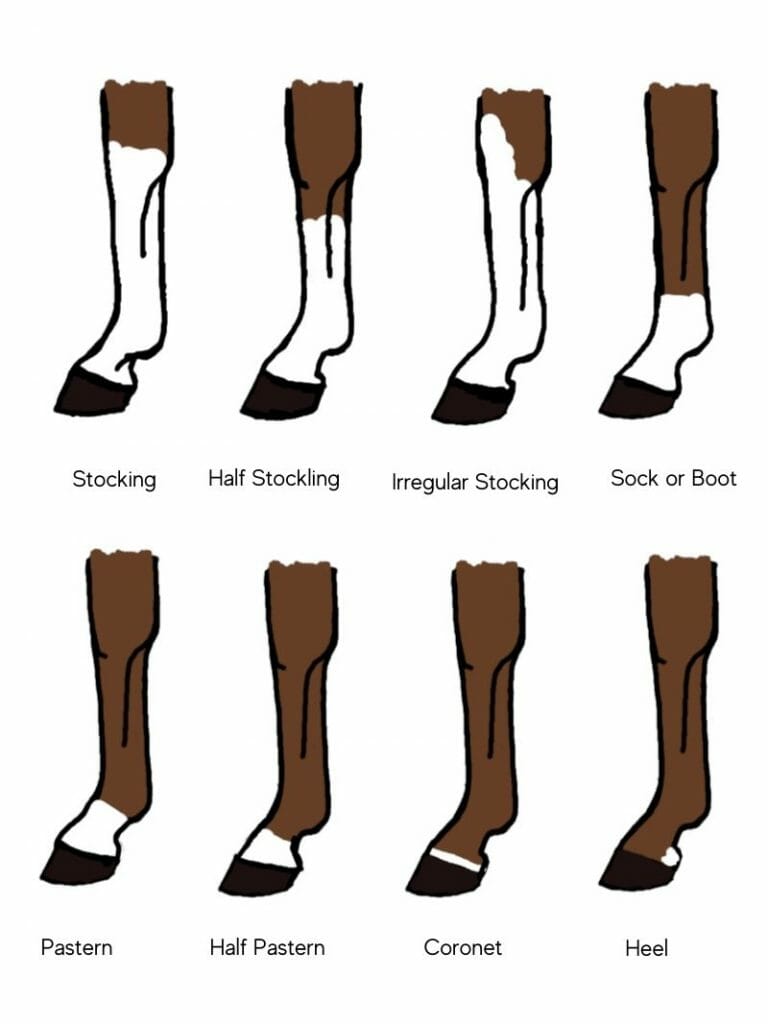Most horses, but not all, have a splash of white on their face and or legs. These are called “markings.” Ever see a beautiful chestnut horse with a thick white stripe on its face and four white legs? These horses are said to have a lot of “chrome.” A term used to describe white markings.
There are typically face and leg markings, but Paint and Pintos can have white markings on their bodies as well. To learn more about paint horse colors and patterns, be sure to check out the Complete Guide To Horse Coat Colors & Patterns: FAQ’S Included.
There are also other markings that are not white, such as on a Dun horse, which has a dark dorsal stripe going down the back, stripes on the legs, and more. If you want to learn more about Dun horse markings, you can check out my blog post: Learn 10 Facts, Differences & Color Shades between Buckskin & Dun Horses.
There are common terms used for leg markings and face markings to properly identify a horse. However, despite the general names used for these markings, each marking will be unique and shaped a little differently from one horse to the next.
Look below to see the chart with drawings of different leg and face markings. Then below the chart you can read the descriptions for each of the markings to learn a little bit more about what makes them those specific markings.
Horse Face And Leg Markings Chart


Horse Face Markings
Face marking terms describe where the marking is and the shape of the marking. Sometimes a horse may have two or three distinct facial markings, which would be a combination. Facial markings can also be irregular in shape.
Some horses with a white marking around the eye have blue eyes. However, this is only sometimes and not always the case.
Bald Face:
A bald face marking extends over most of the horse’s face, including past the eyes. It is common for bald-faced horses to have blue eyes. Bald-faced horses are most common in Paint and Pinto horses. But other breeds can carry this marking as well. Because of the light skin under white hairs and the large area of white on the face, bald-faced horses tend to be prone to sunburns.
Blaze:
A blaze is a wide stripe that covers the bridge of the nose. It goes down the center of the horse’s face from the forehead down to the nose. The blaze can have irregularities where it swerves and is curvy, basically not straight. It may also have broken up areas going down the horse’s face.
Stripe:
The stripe is the same as a blaze but much thinner. Think of a stripe as a painted line on a road and a blaze as the actual road. It might not be a perfect example, but hopefully, you get the idea. A stripe can also have interrupted areas and irregularities like the blaze.
Star:
A star is a white marking that is on the horse’s forehead, either between the eyes or above the horse’s eyes. Stars can be irregular in shape. Stars can be very large or they can be really small. Small stars are usually called faint stars or flecks.
Stars can be in combination with other markings. Such as a horse could have a star and a snip, or a horse could have a star and a stripe, or even a star and a Blaze. However, in combination with a stripe or blaze to be considered a star, it must be significantly wider and bigger than the stripe or blaze.
Snip:
A snip is a white marking that is located on the horses muzzle between the horse’s nostrils. Snips can be off to one side. They can be very small. They can also be really big and cover most of the horse’s nose and muzzle.
Horse Face Markings Variations & Combinations
- Crescent- a star, shaped similar to a crescent moon.
- Faint Star or Fleck
- Interrupted Stripe
- Star Stripe
- Star Blaze
- Star Stripe Snip
- Star Blaze Snip
- Stripe Snip
- Blaze Snip
- Irregular blaze
- Irregular Star
- Irregular Stripe
Common Leg Markings
Horses can have one of these markings on any of their four legs. However, some horses have no leg markings at all.
Typically, there are no combinations of leg markings on one leg. But they can have different markings on each leg.
Leg marking terms are used to describe the height of the white leg marking.
Stocking:
A stocking is a white mark on a horse’s leg that goes up right below the horse’s knee or hock or above it.
Half Stocking:
A half stocking is a white marking that is half way up the horse’s cannon bone or just slightly higher.
Irregular Stocking
An irregular stocking is when one side of the stocking goes up significantly higher, usually far above the knee or hock.
Sock or Boot:
A white marking that covers the horse’s fetlock and is below the half-way point on the cannon bone.
Pastern:
This is a white mark that is below the fetlock but covers the whole pastern of the horse.
Half or Partial Pastern:
This is a white mark that only covers about half of the pastern.
Coronet:
This is a white mark that covers the coronet band right above the horse’s hoof.
White Heel:
This is a white mark that only covers the horse’s heels.
Other Terms Used With Markings
Ermine:
This is a dark spot or marking that is on a white marking, making it look like the white marking has a spot or a hole.
Chrome:
Is a term used for a horse with a lot of white markings.
Combination:
This is when a horse has more than one distinct facial marking.
Irregular:
When a marking does not look uniform, or very even. Has uneven edges.
Interrupted:
When a stripe or blaze is not solid the whole way down but has at least one broken spot.
Connected:
Sometimes used to describe when two different markings are joined to each other.
Faint:
This is for a small permanent marking but is only a few hairs with no pink skin underneath.
High White:
High white are stockings that go above the knee or hock and sometimes go past the stifle onto the belly.
Horse Face & Leg Markings FAQ’s
How Do You Describe Horse Face Markings?
You learn the different terms for horse face markings. The basics are bald face, blaze, stripe, star and snip. You figure out if there is a combination of these face markings, or if there are irregularities and state them, based on what you see on the horse’s face. Horse face marking terms are based on the shape and location of the white marking or markings on the horse’s face.
What Is A Blaze On A Horse’s Face?
A Blaze is a white marking on the horse’s face, which looks like a wide stripe going down the center of the horse’s face.
What Is A Snip Marking On A Horse?
A snip is a white marking that is located between the horse’s nostrils. It can be small or big and be off to the side or right in the middle.
How Do Horse’s Get White Spots?
This is called Vitiligo. The cause is unknown. It is more common in certain breeds than others. But it is a skin condition that causes pigment loss in the hair creating a white circular marking.
Other white spots that form are sometimes from hair getting rubbed off and irritating the skin, growing back with white hairs, such as from halters worn all the time, an ill fitting saddle or a blanket rubbing.
Cheers, Kacey
Related Blog Posts
- Complete Guide To Horse Coat Colors & Patterns: FAQ’s Included
- Bay Horses 101: Learn All About The Beautiful Shades Of Bay
- 16 Dapple Grey Horse Facts With Beautiful Pictures | Breeds List | Resources
- What Is A Flea Bitten Grey Horse? Grey Horse Breeds, Facts, Colors & Photos
- Learn 10 Facts, Differences & Color Shades Of Buckskin & Dun Horses
- All About Blue Roan Horses (Genetics, Facts, Breeds & More!)
- 27 Interesting Palomino Horse Facts With Beautiful Pictures & Some Extras
- Horse Coat Patterns for the American Paint Horse

